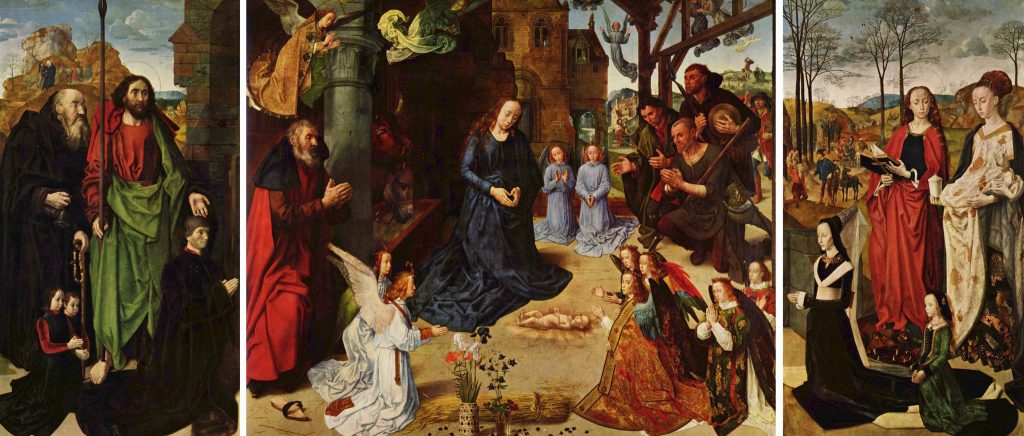One of the treats of lockdown for me has been taking the amazing Zoey Frank’s Multifigure Composition Workshop. She has given nearly two hundred painters from around the world a marvellous series of talks every Friday for the last month on how she approaches composition via zoom, quite a feat! Each week we have been set gouache study homework to encourage more analytical thinking about composition. Last week I chose Hugo Van Der Goes’ Portinari Altarpiece as its such an ambitious painting in terms of time and scale, nearly 50 figures in all in the painting and most of the story of the birth of Jesus is portrayed in the painting in one form or another. I’ve always loved the work for its slightly off kilter quality, the strange architecture, the weird discontinuities in space and scale, the slightly cut and paste nature of the composition, and of course all the hidden monsters.
What I learnt in doing this study is that the picture is far more tightly planned and organized than I had expected. The weirdness and finally observed details obscure the marvelous large forms that make up the painting’s armature: from the left panel the great diagonal dark block that leads you up and into the centre right of the central panel, turning on the angel hovering in the sky who directs you down through the earth coloured Shepherd grouping into the airy right panel full of elegant ladies and saints. Just as the dark areas are punctuated by bright highlights: hands, faces, the lighter areas have offsetting areas of deep rich darks. Both sides of the painting have wonderful bursts of primary colour here and there, particularly gorgeous to me is the gaggle of small sparkly angels in the right foreground. The Portinaris had seven children and only three are painted in the side panels, I wonder whether some of the others are hidden amongst all those small angels. They seem just as real as the huge earthy shepherds bursting into the stable above them.
Meanwhile in the middle distance all the chapters of Jesus’s birth are detailed, from the left Mary and Joseph and the donkey on the way to Bethlehem, Elizabeth and Mary chatting at the gate, the angel announcing the birth of Jesus to the Shepherds on a distant hill, and the Three Wise Men with their entourage arriving from their long journey top right. And in the middle of it all an empty space with a small smudge of gold that is all too easy to miss and that all the fuss is about.
A few years after the painting was finished it was transported from Flanders back to Florence by the Portinari Family. It took several weeks by sea down the Atlantic coast of Spain and through the western Mediterranean and came into Florence up the Arno. When it arrived the entire city ground to a halt to watch the procession of this giant painting to its new home. The Florentines had never seen anything like it before, its cool northern light and realistic portrayal of ordinary people so different from the idealized versions of the world that the Italians were making at the time. For a long time the Altarpiece dominated the Botticelli Room in the Uffizi, hung on the opposite wall to Botticelli’s Birth Of Venus, two utterly different world views expressed in paint. A few years ago it was moved into the Northern Renaissance Room and replaced by Botticelli’s Annunciation Fresco, another extraordinary work. Whilst it is fantastic to be able to get to know a new Botticelli I do miss being able to see the North and the South worlds of the 1480s in one enormous room.


